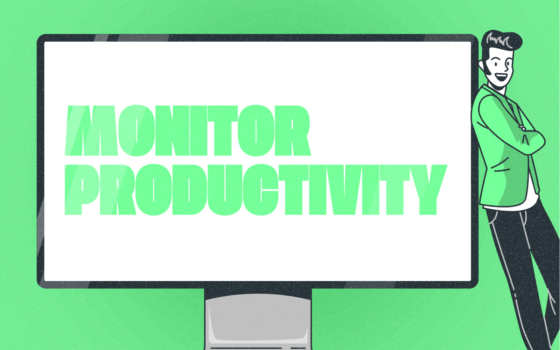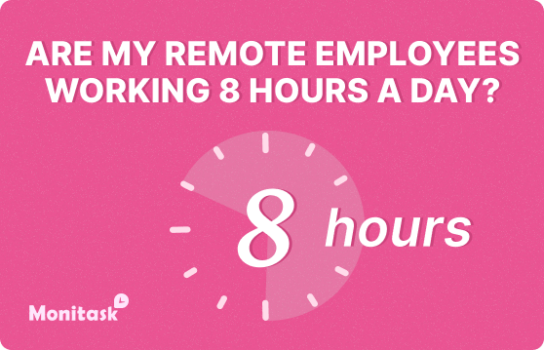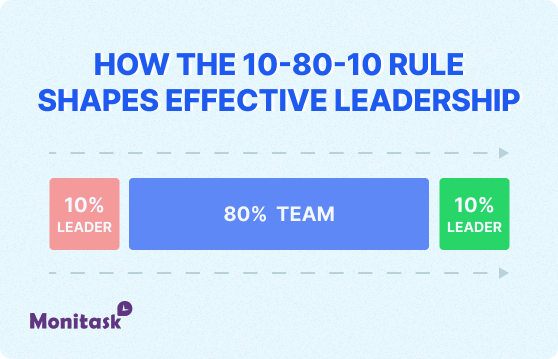
Leadership today is less about being the smartest person in the room and more about creating an environment where others can thrive.
As organizations become more decentralized and fast-moving, leaders must learn to delegate effectively while still guiding their teams toward meaningful results.
The 10-80-10 rule is a framework that allows leaders to strike that balance. It’s not a buzzword—it’s a practical philosophy that encourages ownership,
supports autonomy, and ensures alignment without micromanagement. In essence, it helps leaders lead smarter.
What Is the 10-80-10 Rule
The 10-80-10 principle divides any project or initiative into three parts.
The leader plays an active role in the first 10% of a project—setting direction, clarifying the goals, and establishing what success looks like.
Then, they intentionally step back during the middle 80%, where the team takes ownership of execution, problem-solving, and collaboration.
In the final 10%, the leader re-engages to review the results, help refine the outcome, and close the loop.
Rather than hovering over every detail or being completely hands-off, this model creates a healthy rhythm of involvement. It encourages trust and initiative while ensuring that quality and purpose are never lost.
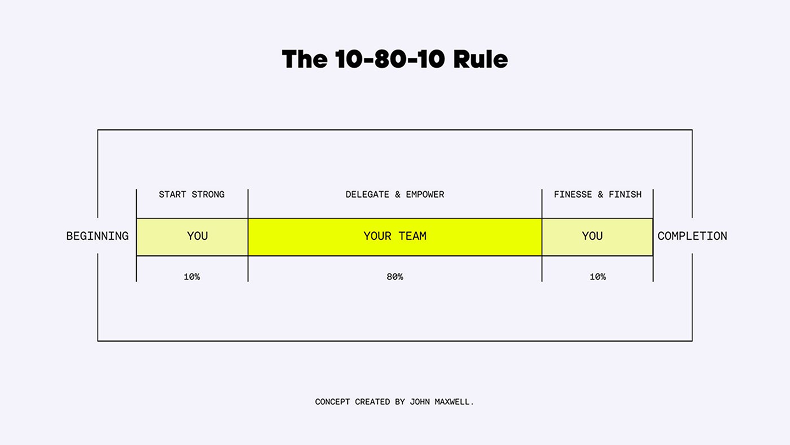
Why This Approach Works
Many leadership models emphasize delegation but often forget the nuances. Simply assigning a task doesn’t mean it will get done well—or that your team will feel supported.
On the other hand, constantly checking in or tweaking your team’s work can stifle confidence and slow progress.
The power of the 10-80-10 rule lies in creating structured independence. The leader is involved at key moments: they provide clarity at the start and polish and feedback at the end. In between, they give the team room to navigate, innovate, and even make mistakes.
This approach builds maturity. It shows that you trust your team while also making it clear that you’re invested in the outcome. It shifts the focus from controlling tasks to influencing results.
Leadership in the First 10%
The first 10% is where the foundation is laid. Think of this as the planning phase, but it’s much more than drafting a to-do list. It’s about setting the tone, the vision, and the constraints that will guide the work ahead.
This is where great leaders ask questions like: “What are we trying to solve?”, “Who is this for?”, and “What will success feel like when we get there?” It’s not about having every answer, but rather ensuring the right questions are being asked upfront. Teams that begin with clear context are far more likely to take ownership with confidence and alignment.
An overlooked benefit of this phase is that it builds strategic thinking muscles in your team. When they understand how their work fits into a broader picture, they begin to lead themselves with purpose.
The 80%: Letting Go Without Losing Sight
Letting go can be one of the hardest parts of leadership—especially for high-performers who are used to being in control. But the middle 80% is precisely where growth happens.
This phase tests not only your team’s abilities but your own capacity to trust. While you may stay aware of key milestones or offer occasional support, your main role now is to stay out of the way. Resist the urge to fine-tune or over-direct unless you’re asked. Your team must feel safe enough to experiment and accountable enough to deliver.
When leaders hover during the execution phase, they unknowingly communicate doubt. But when they step back intentionally, they send a different message: “I believe in you.”
This doesn’t mean being absent. It means being available but not intrusive—checking in through pulse meetings, not panic calls.

The Final 10%: Guiding the Finish Line
As the work nears completion, the leader returns to bring a second wave of clarity and momentum. This is the moment for course correction if needed, polishing the message, or making the final presentation pop. It’s not about redoing the work—it’s about helping your team finish strong.
What matters here is tone. When leaders swoop in too critically, they can undercut the confidence built during execution. But when they come in as collaborators—asking thoughtful questions and appreciating the effort—trust deepens.
This is also a great time to reflect on what went well, what could be improved, and what should be celebrated. Recognition becomes a cultural signal: it tells your team that what they created matters.
Maximize productivity of your business
Track employee productivity and simplify work with them
The Psychological Safety Behind the 80%
One of the most powerful effects of the 10-80-10 model is that it naturally creates psychological safety.
When team members know they have ownership of the core work (the middle 80%) without the fear of constant correction or micromanagement, they become more willing to take risks, suggest improvements, and learn through doing.
This freedom doesn’t mean chaos—it means your team has the space to think critically, fail safely, and grow. Psychological safety is a foundational element in high-performing teams, and the 10-80-10 model inherently supports it by creating clear lanes of responsibility and trust.
When people aren’t worried about being second-guessed at every step, their creativity and performance can truly flourish.
10-80-10 in Remote and Hybrid Teams
The rise of remote and hybrid work has made the 10-80-10 rule even more relevant. When you can’t physically pop into someone’s office or walk past their desk, trusting your team to manage their 80% independently becomes essential.
By clearly defining the starting goals and outcomes, remote leaders give their teams the clarity they need to take initiative. Checking in at the end—not every hour—keeps people productive without adding stress.
Plus, in distributed environments, this framework encourages asynchronous collaboration. Teams can execute their part of the project across time zones, while the leader focuses on shaping the direction and refining the results—rather than managing the hour-by-hour grind.
Coaching Moments: Turning the Final 10% into Growth
The final 10% isn’t just a time to tweak deliverables—it’s also the ideal moment for coaching and mentoring. Here, leaders can offer constructive feedback, praise strong execution, and help team members reflect on how they approached the task.
Rather than simply saying “good job” or “here’s what to fix,” take the opportunity to ask:
- What did you find challenging?
- How did you decide on this approach?
- What would you do differently next time?
These coaching conversations turn project reviews into moments of learning and leadership development, deepening skills and building confidence across the team.
When to Adjust the 10-80-10 Approach
While the 10-80-10 rule is flexible, it’s not always the right fit. In crisis situations, mission-critical launches, or when working with inexperienced teams, leaders may need to remain more involved throughout the process.
However, the spirit of the framework—start strong, empower the middle, support the finish—can still guide your approach. Use your judgment and adapt as your team’s needs and project stakes evolve.
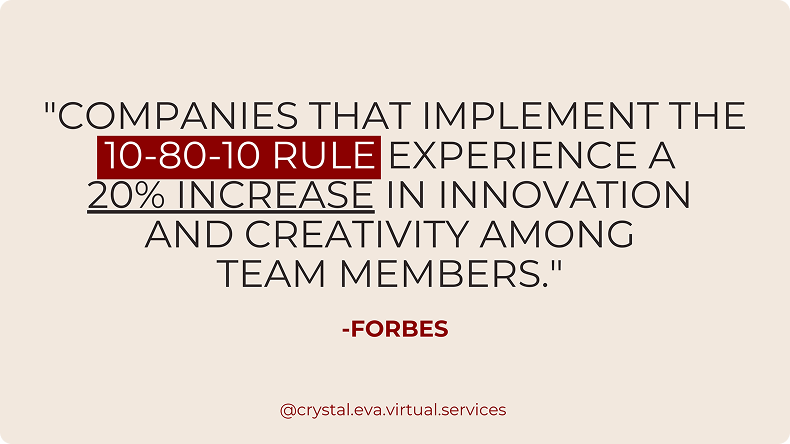
Conclusion: Build Capability
The best leaders don’t build dependency—they build capability. The 10-80-10 rule is a roadmap for doing just that. It reminds us that leadership isn’t about being in every detail—it’s about being present where it counts.
When you set the stage thoughtfully, trust your team to deliver, and guide them across the finish line, you foster a culture of accountability, confidence, and high performance.
Leadership is not about doing the work—it’s about making others better at doing it. The 10-80-10 rule is how you start!
– The Monitask Team
FAQ: The 10-80-10 Leadership Rule
How do I know when to step back during the 80%?
If your team understands the goals, expectations, and boundaries, it’s time to step back. Your role shifts from directing to observing, supporting, and being available if needed.
What if the 80% goes off track?
That’s where the final 10% matters. Rather than stepping in too early, give your team room. If correction is needed, use that final phase to align the output.
Can this work with junior or new employees?
Yes, but the level of support in the 80% might be higher. Over time, as skills grow, the leader can step back more fully.
What if I enjoy being hands-on?
Great! Hands-on doesn’t have to mean micromanaging. Use your skills to shape the project’s direction and support your team during coaching moments—without taking over the middle.

